The Hogs are out of conference and even out of subdivision this week, taking on the Bears of Missouri State. There’s some shared history between these two schools, with seven all-time matchups and two head coaches that coached at both schools, including current Head Bear Bobby Petrino.
Meet the Bears
Confused by any of the advanced stats you see here? Be sure to check out the glossary.
Missouri State is 2-0, courtesy of a 27-14 win over UCA and a 35-30 win over UT Martin. Their offense struggled against the Purple Bears. It was 0-0 until a Bears field goal with six minutes left in the first half, and then a punt and turnover led to Missouri State putting up a quick 14 points in the final four minutes of the first half. Those would be all of Missouri State’s offensive touchdowns, as a kickoff return made it 27-7 early in the fourth quarter. UT Martin was a back-and-forth shootout, with Missouri State eventually getting a couple late touchdowns and holding the Skyhawks to a couple of red zone field goals to provide the final margin.
Missouri State is ranked 5th in the FCS poll, so they are much stronger than the average FCS team.
We don’t have advanced stats data on FCS schools, so we’ll just be showing Arkansas’ numbers.
Recent posts
- Box Score Breakdown: Texas Tech 85, Arkansas 83
- Matchup Analysis: 3 Texas Tech
- Box Score Breakdown: Arkansas 75, St. John’s 66
- Matchup Analysis: 2 St. John’s
- Box Score Breakdown: Arkansas 79, Kansas 72
Scouting Report
The Bears’ offense is classic Petrino, with crossing routes and lots of verticals. Their quarterback is an accurate passer and is dual-threat. The receivers are really talented by FCS standards. The offensive line is a major weak point. It struggles to open up rushing lanes and struggles to protect its quarterback.
The defense isn’t as good as the offense, but it’s good enough to keep Missouri State in games. Its best playmakers are in the secondary.
Three Names to Know
- Jason Shelley. The Bears’ quarterback is up for the FCS version of the Heisman. He’s pretty accurate with his arm and is a willing runner. He sometimes has too much faith in his athleticism and can run himself into sacks, but overall, he does a good job of running this offense.
- Tyrone Scott. The Bears’ receivers are pretty good overall, but Scott is head-and-shoulders above the others. He’s extremely physical after the catch and breaks a lot of open-field tackles. He’s absolutely an FBS-caliber receiver and will provide a major challenge to the Hogs.
- Montrae Braswell. The Bears’ top cover-corner is all-conference and also a dangerous return man. He took one back for a touchdown against UCA. He leads the team with 11 solo tackles already this season.
When Missouri State has the ball

The Razorback defense isn’t ideal territory after two weeks, thanks to a banged-up secondary. With the news that Myles Slusher should return and a step down in competition, the Hogs have to feel better. Right now, Arkansas is doing a nice job of creating turnovers and limiting opposing points in the scoring zone. That’s bending and not quite breaking, though the explosive plays have to come down.
One issue: the Hogs are facing off against the master of explosive plays.
The Bobby Petrino offense
Hog fans are definitely familiar with Petrino’s fireworks-inducing offense. But let’s take a closer look nonetheless.
Petrino’s earliest influence was the Price/Erickson Oneback offense. This offense is named for its two early adaptors: Mike Price and Dennis Erickson. Price led Washington State and QB Ryan Leaf to the Rose Bowl, while Erickson won the 1989 and 1991 national titles at Miami. Though they never actually coached together, they spent time at the same schools (namely Washington State, where both were head coaches at different times). Petrino was a GA under Price at Weber State in 1984. His big break came when John L. Smith, Price’s defensive coordinator at Idaho, Wyoming, and Washington State, was hired as Idaho’s head coach in 1989. Smith wanted to keep running the Oneback, so he hired Petrino as his offensive coordinator, as the rest is history.
The original Oneback offense used 11 personnel – 3 WR, 1 TE, and 1 RB – and was innovative in the schemes it used to attack the coverages of the time. Petrino continued to evolve it, borrowing heavy from Steve Spurrier’s Fun-N-Gun offense during the 1990s. Spurrier’s genius came in that while everyone at the was focused on using the passing game to stretch the defense horizontally (the West Coast offense was dominant in both college and the NFL), Spurrier realized there was a lot of opportunity to stretch the defense vertically. Many of Spurrier’s main routes – posts, fades, and wheels – have been incorporated into other schemes, including Petrino’s.
Petrino’s playbook emphasizes complicated plays in a simple playbook. The actual size of Petrino’s Arkansas playbooks are pretty small compared to, say, a West Coast offense playbook. But Petrino preferred to layer several different concepts into a single play, so the play could be used to attack any defense. Arkansas ran a handful of simple-but-effective passing concepts that were packaged into several different similar-looking plays.
The most famous Petrino play at Arkansas is, by far, Shark. Here it is in Petrino’s 2004 playbook when he was at Auburn:

Or, if you’re like me and learned about the Petrino offense by playing NCAA Football 14, then maybe this will be familiar:

There are actually three different two-route concepts happening here. Let’s look at them:
- Shallow Cross. That’s the underneath crossing route by the slot receiver. The tight end’s deeper square-in should pull back the linebackers so the shallow crosser will be open underneath. This is a common Price/Erickson Oneback concept, and an underneath shallow crossing route is a feature of almost every dropback pass in Petrino’s playbook.
- Mills. That’s the post over the square-in. This is a classic Spurrier design. The square-in from the tight end, in addition to working the Shallow Cross, also pulls down the safety in some coverages, which would leave the post wide open for a home run play. The first FBS touchdown of the 2013 season was scored by Spurrier’s South Carolina on a Mills play where the safety jumped the underneath route.
- Post/Wheel. This is adapted from the old Spurrier “slot wheel” concept that acts as a Cover 3 beater: the post route moves the safety over so the wheel is wide open. Petrino ran slot wheels on occasion, but found more success having his running back run the wheel out of the backfield.
Petrino designed several variations of this play, but the basic concepts are the same. This is the play that Ryan Mallett diagrammed for Jon Gruden on Gruden’s QB Camp ahead of the 2011 draft.
On the second play from scrimmage against Alabama in 2010, Petrino dialed this play up for one of the best-known touchdowns of his time in Fayetteville:
Shark – “Post/Wheel”
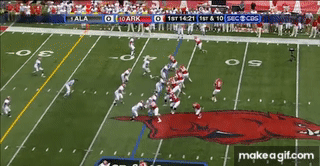
With six seconds left in the first half against LSU later that season, what’s Petrino calling? You guessed it:
Shark – “Mills”
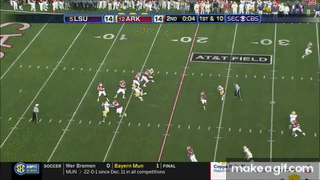
As mentioned above, a large portion of Arkansas’ offense was just a few basic concepts dressed up to look a little different. Here’s the shallow cross concept from the diagram above, but now the square-in and crosser are coming from the same side. This concept is called “drive” but it is functionally the same as “shallow cross”:
Shark – “Drive” (Trips)
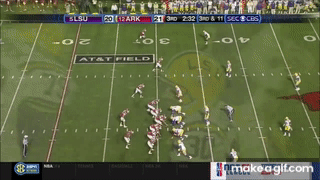
Note the running back taking off on the wheel route at the bottom of the gif.
As exciting as the highly-vertical 2010 Razorback offense was, it was always going to be hard to replicate. First, quarterbacks with arms like Mallett’s are not easy to find. Second, defenses have adjusted in recent years to make it harder to rely on extremely vertical passing. Kendal Briles has had to deal with the same issue, as have all offensive coaches who rely heavily on vertical stretches.
This adjustment started as early as 2011, when Alabama and LSU saw the Hogs again, this time with Tyler Wilson at quarterback. Both used a lot of Cover 1 looks, playing tight man on the receivers with a robber safety underneath to limit the gains on shallow crosses. Petrino’s offense takes a while to get through its many progressions against man, and both Alabama’s and LSU’s pass rush arrived well before Wilson could look over all his options. As good as Arkansas’ receivers were, they were much better catching the ball on the run, so potential counters like fade routes up the sideline were hard for the Hogs to pull off.
Louisville (2014-2019)
After Petrino was fired at Arkansas and turned up at Louisville, he continued to try and fix the potential ways to stop his scheme. An obvious one emerged against man coverage: a running quarterback. The vertical routes of his offense take the opposing secondary way down the field, meaning any quarterback that takes off will have lots of green in front of him. At Louisville, he recruited Lamar Jackson, installed some of the pistol read-option concepts he’d originally put in for Brandon Mitchell in 2011, and told Jackson to take off if he saw green. A Heisman campaign was born, but it masked the sad fact that Petrino’s time in major college football was running out. His bad reputation – both from his Arkansas exit and from the fact that it was known he’s hard to work for – made it hard for him to hire and keep good assistants. Louisville’s recruiting never really got going. After Jackson left for the NFL, the Cardinals sank to 3-9, and that was that.
Missouri State (2020-Present)
Now Petrino is off to a quiet retirement in Springfield, a career of brilliance and missed opportunities mostly behind him. He has the once-moribund Bears competing for the top of the FCS.
Watching the Bears, you’ll see a lot of classic Petrino plays. There’s a shallow crosser or slant route in almost every pass, shown here with the “scat” motion that he’s used frequently:
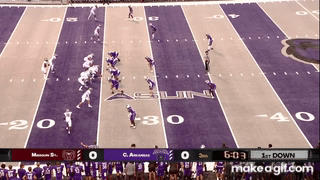
And the beloved and dangerous running back wheel route? Oh, it’s still there:
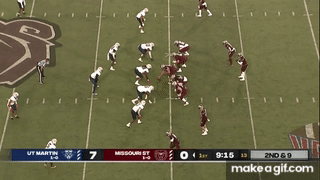
Expect it on Saturday.
Quarterback Jason Shelley is his new Lamar Jackson. If he sees man coverage and green grass (or in this case, a mix of purple, gray, black, and white grass), he’s taking off:
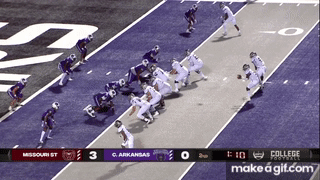
To be clear, Shelley is not anywhere near as mobile as Jackson. His attempts to escape the pocket frequently go sideways:
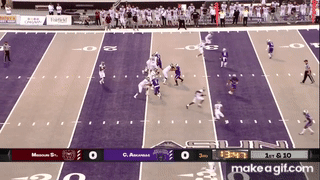
One interesting thing about how opposing defenses are playing Missouri State: they aren’t blitzing. Both UCA and UT Martin gave the Bears the full Barry Odom rush 3, drop 8 experience. Both used a 3-man line. Blitzes were very rare but usually very effective:
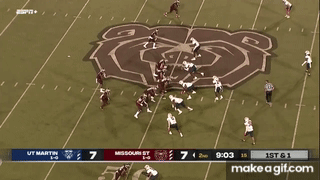
I expect Arkansas to use a 3-man line on Saturday, with Dime personnel on the field most of the game. Against South Carolina, I saw some 3-3-5 looks with Chris “Pooh” Paul acting as the third linebacker. Missouri State’s offensive line is really not very good, so it would be stunning if they have any success at all pushing the Hogs around, even with just three linemen.
As far as coverages go, UT Martin primarily played zone and the Bears shredded it. UCA, on the other hand, had some success frustrating Shelley by playing the same Cover 1 that Alabama and LSU played back in 2011.
Here, Shelley is indecisive and ends up having to run around before making a bad throw:
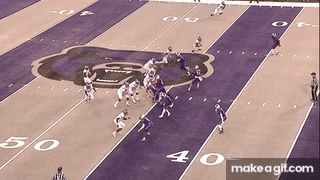
Missouri State eventually strung together some completions against man by going to their best receiver, Tyrone Scott. He had 8 catches for 160 yards against UCA and 8 catches for 96 yards and two touchdowns against UT Martin. He’s difficult to tackle, so they’ll try and get him the ball in space, one-on-one:
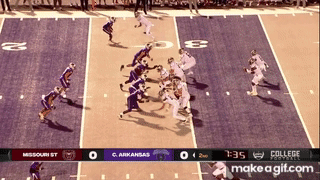
Missouri State’s run game is not as much of a threat. Shelley can keep on read options and will also scramble. Lead back Jacardia Wright had just 13 carries for 38 yards against UCA, but had 23 carries for 120 yards against UT Martin. UCA’s defensive line really dominated Missouri State’s offensive line, which caused the Bears a lot of issues.
When Arkansas has the ball
While Bobby’s son Nick Petrino is the offensive coordinator, the Bears’ defensive coordinator is Ryan Beard, who is… Bobby’s son-in-law. It’s a family affair in Springfield.

The Razorbacks’ explosiveness has dropped significantly since most of the data is now from the last two weeks, but the offense is rising in the rankings because it is efficient, it doesn’t turn it over, and it finishes drives. It doesn’t get much better than that. Once the explosive plays come, watch out.
Defensively, the Bears are multiple. Against pass-heavy UT Martin, they used a 3-man line and often had six defensive backs. Against UCA, a more traditional 3-wide offense that was breaking in a new quarterback, they played with four defensive linemen in a 4-2-5 or 4-3 Nickel look.
UCA’s top two backs combined to rush 26 times for 183 yards. The Bears’ defensive front seems unlikely to hold up against Arkansas’ rushing attack. The back end of the Bears’ defense is pretty strong, with cornerback Montrae Braswell named as a potential FCS all-American. Braswell also returned a kickoff for a touchdown against UCA.
The Hogs can probably get whatever they want on the ground, but I wouldn’t be surprised if Kendal Briles wants to take the air after the run is established, in order to build more rapport with these receivers.
Keys to the Game
Tackle in space. The Petrino offense is big on getting receivers the ball on the move. If the Hogs do try some rush 3, drop 8 looks, expect the Bears to hit a lot of underneath shallow crossing routes, which are only really dangerous if the receiver breaks some tackles. If the Hogs go man, expect to have to deal with Shelley as a scrambler in space.
Hit some deep shots. The explosiveness in the passing game that we saw last year hasn’t shown up this year. Most of it is the loss of Treylon Burks, but some of it is the gameplan for Cincinnati and South Carolina, as both had strong secondaries and weaker fronts. Against an FCS team, I’d like to see KJ Jefferson build some more rapport with his receivers on deeper routes.
Avoid injuries. This is always a key against an FCS opponent. The Hogs have a monster stretch coming up, so losing anyone would be devastating.
The latest from Fayette Villains, straight to your inbox
Enter your email to subscribe and receive new post alerts and other updates. You can unsubscribe at any time.